Canada? nursing workforce grows 9% in five years
Registered nurse?to-population ratio still lower than in the early 1990s
Regulated Nurses : Canadian Trends, 2005 to 2009 at: http://bit.ly/faFPnS
Between 2005 and 2009, Canada gained just more than 27,000 nurses, bringing the total regulated nursing workforce to approximately 348,500, according to a new report released today by the Canadian Institute for Health Information (CIHI). This represents an increase of 9% in the number of working nurses over five years. In comparison, the Canadian population grew by 5% over the same period.
CIHI’s report, Regulated Nurses: Canadian Trends, 2005 to 2009, examines supply and workforce trends for Canada?s largest group of health care professionals at the national, provincial and health region levels. Three-quarters of the Canadian nursing workforce is made up of registered nurses (RNs), followed by licensed practical nurses (LPNs) and registered psychiatric nurses (RPNs). RPNs are regulated exclusively in the four Western provinces and one territory (since 2009).
Between 2005 and 2009, Canada’s regulated nursing workforce grew by nearly 9%. Growth in the RN and LPN workforces has exceeded the growth of the Canadian population.
In 1992, there were 824 RNs for every 100,000 Canadians, compared to 789 RNs for every 100,000 Canadians in 2009.
Between 2005 and 2009, the average age of a Canadian nurse remained stable at 45.
In 2009, 37% of RNs in the workforce had obtained a baccalaureate as their highest level of education in nursing, compared to 32% in 2005.
The number of LPNs increased by more than 18% between 2005 and 2009, outpacing growth in the Canadian population.
The number of NPs more than doubled between 2005 and 2009 and increased by 22% between 2008 and 2009. NPs represent only 0.7% of the total registered nursing workforce.


